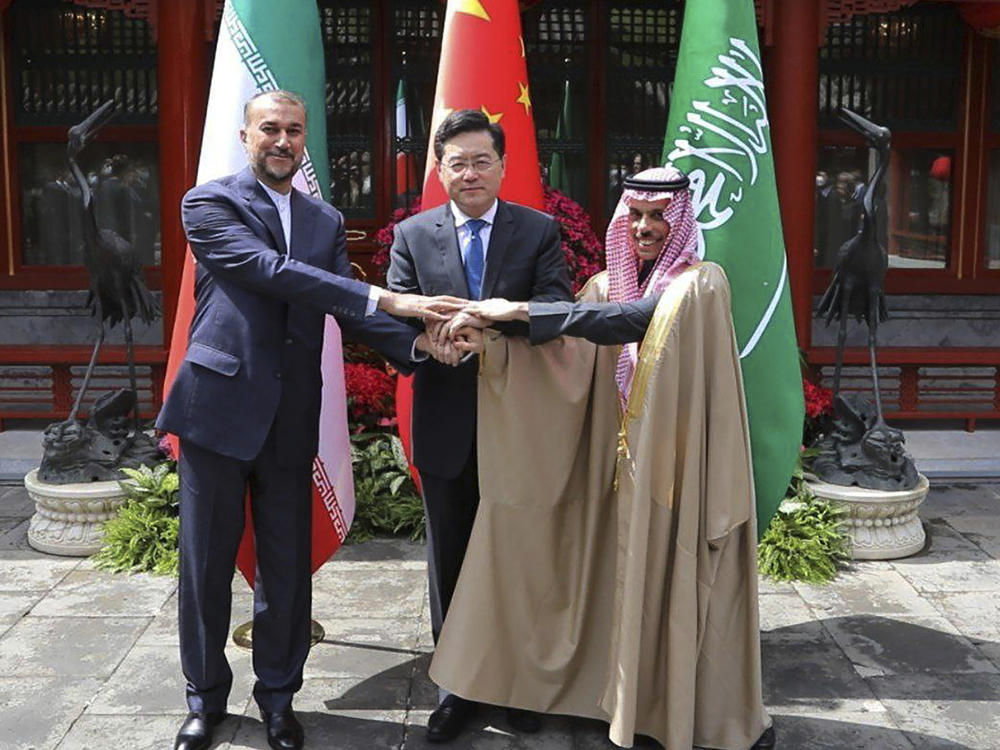Section Branding
Header Content
Top Saudi and Iranian envoys meet in China for a deal that could remake the region
Primary Content
DUBAI, United Arab Emirates — Years of proxy fighting, missile strikes and mudslinging could be winding down with Thursday's first face-to-face meeting of Saudi Arabia's and Iran's top diplomats in more than seven years.
Saudi Arabia's state-run al-Ekhbariya news channel showed Prince Faisal bin Farhan and his Iranian counterpart, Hossein Amirabdollahian, shaking hands, sharing smiles and sitting side by side.
Iranian media reported the ministers signed a joint statement to confirm the reopening of their embassies and consulates, as well as resuming direct flights and facilitating visas for citizens. The statement also emphasized the importance of reinstating decades-old agreements on security cooperation, trade and investment.
It's a turn for regional foes that have spent years embroiled on opposite sides of the wars in Yemen and Syria, and spent huge sums to back rival factions in Lebanon and Iraq.
The meeting between the Saudi and Iranian senior diplomats in Beijing carries important optics for Muslims, too, as it comes during the Islamic holy month of Ramadan, where patience, compassion and mercy are encouraged.
The meeting also has political significance for China, which hosted. A major buyer of oil from both countries, it has ambitions to increase its clout in the region. That poses a challenge to the U.S., traditionally the biggest foreign power and dealmaker in the Mideast.
Saudi Arabia and Iran had been engaged in low-level talks mediated by Iraq and Oman for two years but it was China that helped seal the deal last month. It called for re-opening embassies and reviving old deals on trade and security.
Pivoting away from war, for now
Each country has its own reasons for wanting to de-escalate tensions now.
Saudi Arabia's Crown Prince Mohammed bin Salman wants to end the years-long war in Yemen. There, the kingdom has tried but failed to restore to power the country's internationally-backed government, which was ousted by Iran-backed Houthi rebels. The war has cost tens of thousands of Yemeni lives and saw Saudi cities, airports and oil facilities targeted by Iranian-made drones and missiles.
The China-brokered deal to restore ties between Saudi Arabia and Iran could help lead to a permanent ceasefire between the Houthis, Saudi Arabia and other warring parties.
This would free up Saudi Arabia to focus more on the Crown Prince's many mega-projects inside the kingdom, which are intended to create millions of new jobs for young Saudis and diversify the economy away from oil.
For its part, Iran is facing diplomatic isolation, its currency and economy is under intense pressure from U.S. sanctions and its cities were roiled by youth-led protests for months recently. As a member of the Saudi-led OPEC oil cartel, Iran wants to be able to sell more of its crude but is limited by U.S. sanctions. The deal could bring investment and trade ties with Saudi Arabia, the region's biggest economy.
Huge promises and huge hurdles
An end to open Saudi-Iran animosity has the potential to calm conflicts and power struggles in Syria, Lebanon and Iraq. Already, countries like the United Arab Emirates, Bahrain and Egypt are improving their ties with Iran.
But how far the peacemaking goes or lasts depends on whether the two regional powers can truly mend ties. Saudi Arabia, the UAE and Bahrain remain deeply suspicious of Iran's nuclear program, as well as its paramilitary force and support for Iranian proxy militias in the region. They are also concerned about Iran's ballistic missile and drone capabilities — hardware that's being tested and used on the battlefield by Russia in its war in Ukraine.
There are also Sunni and Shia Muslim hardliners on each side that oppose deeper engagement and rapprochement. Additionally, Israel's continued strikes against Iranian targets, including in Syria, remain a source of uncertainty.
Meanwhile, China's role in the Middle East gets a boost. The U.S. is still by far the biggest foreign military force in the region but its attention has increasingly turned toward containing Russia and China. Gulf Arab states have expressed concern that the U.S. can't be trusted to defend them against attacks from Iran. Analysts say that while the U.S. remains Saudi Arabia's top security partner, the kingdom has made clear it will not side with the U.S. against China or Russia.
Thursday's meeting between Saudi Arabia and Iran's foreign ministers is the clearest sign yet that both countries, for now at least, see it in their interest to de-escalate tensions, rebuild ties and reassess their rival policies in the region.
Copyright 2023 NPR. To see more, visit https://www.npr.org.

